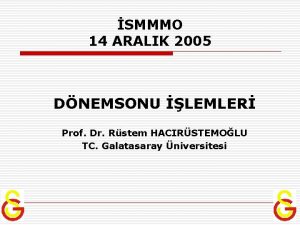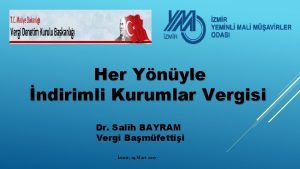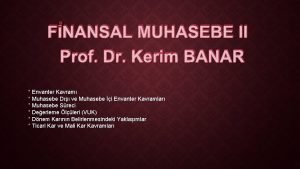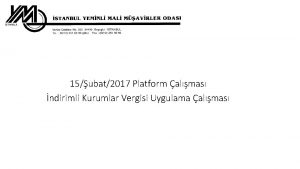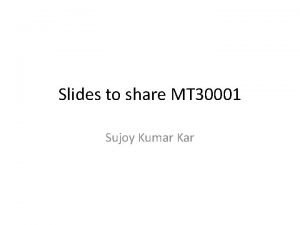Slides to share MT 30001 Sujoy Kumar Kar




- Slides: 4

Slides to share MT 30001 Sujoy Kumar Kar

Syllabus: Will email you this slide MT 30001: MATERIALS ENGINEERING (3 -0 -0) Introduction: Solid Engineering Materials- their classification and characteristic properties. Structure of solids: crystal systems/lattices, crystal structure, crystallographic planes and directions, interstitial sites, crystallinity in metals, ceramics, semiconductors and polymers, microstructures and metallography, amorphous or glassy state. Solidification of pure metal: Homogeneous and heterogeneous nucleation processes, cooling curve, concept of supercooling, microstructure of pure metals. Defects in solids: Point, line, planar and volume. Fundamentals of plastic deformation of metals, deformation by slip and twin, plastic deformation in polycrystalline metals, concept of cold working, preferred orientation. Annealing: Recovery, recrystallization and grain growth, hot working. Properties of materials: Definition, units and common tests conducted to evaluate important engineering properties like physical, mechanical, chemical, electrical, magnetic, semi/super-conducting, optical, and thermal properties in engineering materials. Concept of formation of alloys: Types of alloys, solid solutions, factors affecting solid solubility, order disorder transformation. Binary phase diagrams: Isomorphous, eutectic, peritectic, eutectoid and peritectoid systems, effect of non equilibrium cooling, coring and homogenization. Iron-cementite diagram: Construction and interpretation Fe-Fe 3 C and Fe-Graphite diagrams. Microstructure and properties of different alloys in steel and cast iron, types of cast iron, their microstructures and typical uses. Heat treatment: T-T-T and C-C-T diagrams, concept of heat treatments of steel - annealing, normalizing, hardening and tempering, microstructural effects brought about by these processes and their influence on mechanical properties. Effect of common alloying elements in steel, concept of hardenability, factors affecting it Ferrous and non-ferrous alloys: Common alloy steels, stainless steel, tool steel, high speed steel, high strength low alloy steel, microalloyed steel, specifications of steels. Physical metallurgy of common non-ferrous alloys: Cu-, Al- and Ni- based alloys. Microstructures and heat treatment of common alloys of these systems Engineering ceramics and polymers: Structure, properties and application of common engineering ceramics and polymers. Composites: Principle, structure and application of composites. Text Books: 1. W. D. Callister, Jr: Materials Science and Engineering- An Introduction, John Wiley and Sons, N. Y, 1985. 2. J. F. Shackelford: Introduction to Materials Science for Engineers, Mc-Millan Publishing Co. , N. Y. 1992. 3. W. F. Smith: Principles of Materials Science and Engineering, Mc Graw Hill Int. , 1986. 4. V. Raghavan: Materials Science and Engineering, 4 th Ed. , Prentice Hall of India, 1998.

Students’ Presentation • Every group should have 5 people • Maximum of 3 groups can give presentation on a particular topic (Topic will be alloted on first cum first serve basis) • Presentation duration for a group 15 minutes • Every member of a group has to present a few slides • These will be part of the exam syllabus • Attendance marks towards TA would be ignored if you give sincere effort towards this presentation • Encourage everyone to participate. • Send me one email for each group, by giving the names and roll numbers of the group members and the topic by this Friday (22 July 2016). Topics will be alloted on first cum first serve basis.

List of topics 1. 2. 3. 4. 5. 6. 7. 8. 9. 10. 11. 12. 13. Material for automobile applications Material for aero-engine applications Material for aircraft structural applications (other than the engine) Material for bio applications (implants etc. ) Smart materials – Various applications Material for IC chips/ semiconductors/ electronic materials Ti alloys – Types, microstructure, applications Ni based superalloys – Applications and science behind Materials for applications of your imagination – Futuristic material/ Materials of science fiction Material for underwater drills in Oil and gas sector Material for data storage devices – Magnetic materials Nano materials (Carbon nano tube etc. ) – Applications 3 -d printing of materials
